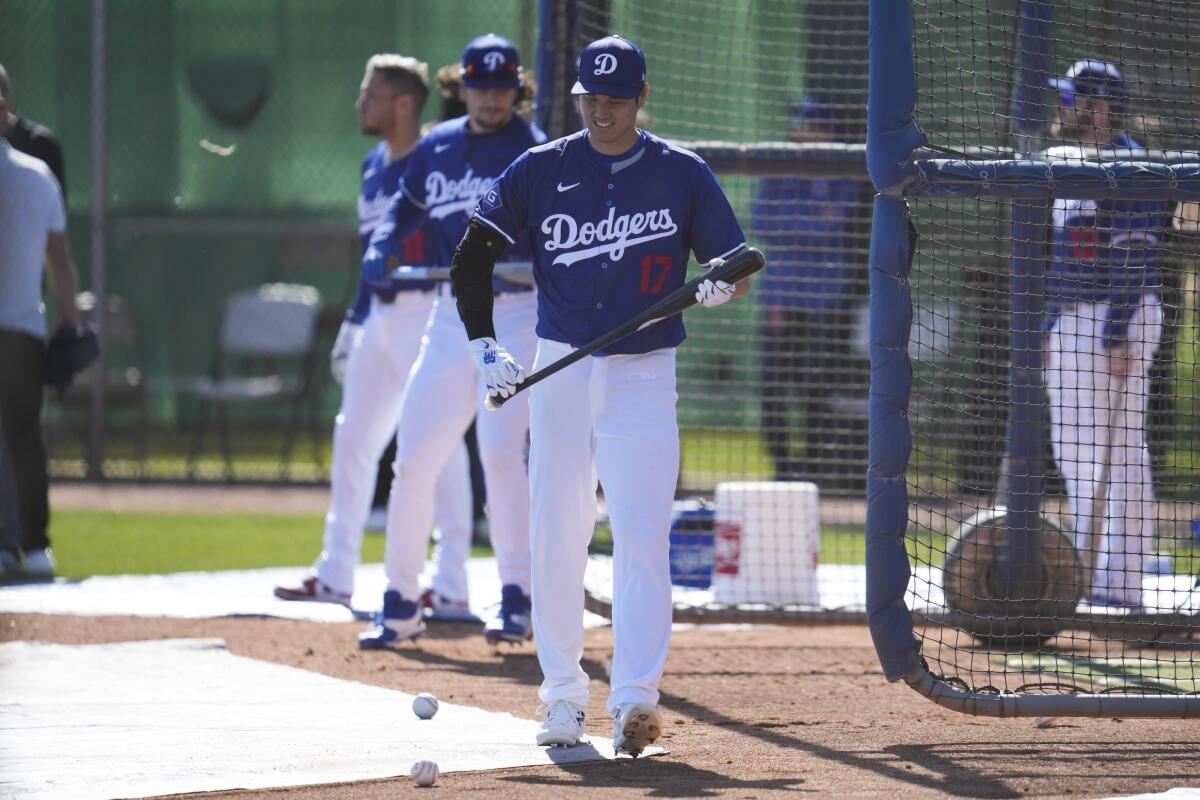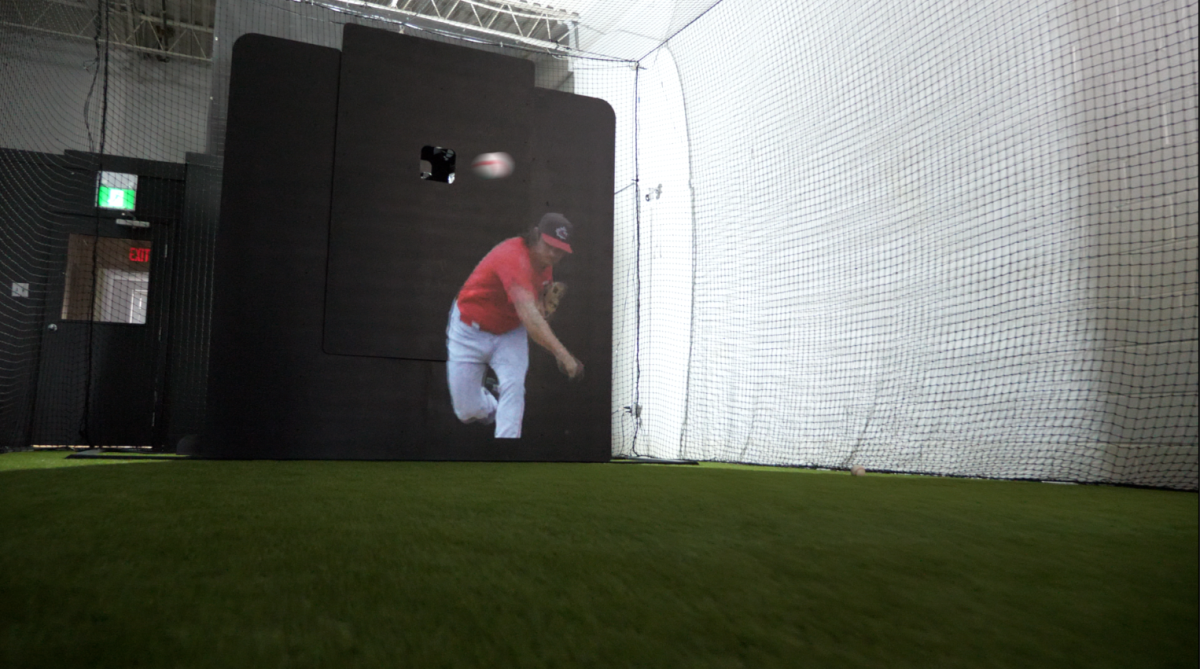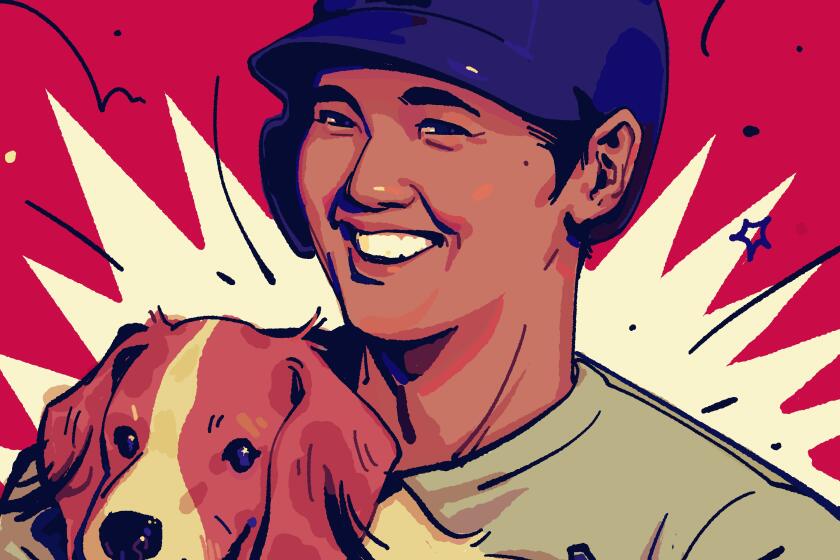How Shohei Ohtani and other Dodgers get their swings in: Games, BP... and a Trajekt Arc?

PHOENIX — Early on this spring training, Shohei Ohtani told Dodgers coaches he wanted to take 50 at-bats before the start of the regular season.
To reach the mark before the team’s opening day series in South Korea next week, the two-way star knew it would take more than just a handful of Cactus League exhibition games.
That’s why, when Ohtani discussed his 50 at-bat target with reporters last month, he noted three ways he could build toward his total.
- Getting normal plate appearances in official spring games.
- Taking live batting practice against Dodgers teammates on the Camelback Ranch backfields.
- Facing a robotic pitching machine called Trajekt Arc.
Tyler Glasnow will be the Dodgers’ opening day starter, the team announced Monday, for its March 20 lid-lifter against the Padres in Seoul.
If the latter sounds out of the ordinary for traditional preseason training methods, that’s because — in the latest example of baseball’s rapid technology revolution — it very much is.
This year, the Dodgers opened a new indoor training facility at Camelback Ranch, constructing a 12,000-square-foot building where their old open-air hitting cages used to be.
The space — nicknamed “The Lab” by players and coaches — is the new technological hub of Dodgers camp, home of data-driven training tools such as force plates, motion-capture cameras and biomechanical tracking systems.
Of all the new high-tech toys at the Dodgers’ disposal, though, the Trajekt Arc machine has been one of the most-lauded, allowing batters to take simulated at-bats against any MLB pitcher, and any of their specific pitches.
“It’s really cool,” said Chris Taylor, one of several players who have used the Trajekt machine extensively this spring. “I don’t even know how they do that.”
Joshua Pope, chief executive and co-founder of Trajekt Sports, can explain.
A decade ago, when he was a high school student in Toronto, Pope and some friends were at a Blue Jays game, watching Marcus Stroman pitch, when they started kicking around a hypothetical bet.
“How many swings would it take,” they wondered, “to actually make contact off Stroman?”
When Pope started looking at the Statcast data behind Stroman’s pitches — which measures everything from velocity to spin rate and horizontal and vertical break — he had an epiphany.
With all that information, he realized, “you can actually visualize the trajectory of every pitch.” And if it’s possible to visualize the shape of a specific throw, he thought, then “why isn’t there a way to replicate these pitches [in real life]?”
Thus, in college at the University of Waterloo in Canada, that’s what Pope tried to achieve. Inspired by a robotic hockey slap-shot machine built by one of his professors, he started creating designs for a system that would eventually become the Arc machine.
It wasn’t a seamless process. Pope and his co-founder, Rowan Ferrabee, had to devise a way to generate life-like spin on the ball using a three-wheel pitching machine (“If you rotate the wheels off-axis,” Pope explained, “you can get the gyro spin” needed to emulate breaking pitches).

They created a ball insert that effectively replicates a pitcher’s grip, making sliders and curveballs look the same as if an actual pitcher had thrown them.
To top it all off, they added a gigantic video screen to the front of the machine. Before every “pitch,” the screen displays a video of the selected pitcher’s wind-up. Then, in the exact same spot as the pitcher’s release point, a hole opens in the screen through which the ball comes zipping out.
“It’s a great tool,” manager Dave Roberts said. “A lot of those guys are in there all the time. It just gives you that real live look at a pitcher.”
It’s not a perfect replication of a real-life at-bat, with some parts of a delivery, such as a pitcher’s extension toward the plate, unable to be imitated.
Not all Dodgers have obsessed over the Trajekt machine, either. First baseman Freddie Freeman, for example, still prefers more traditional drills hitting balls flipped to him or placed on a tee. Others, like catcher Will Smith, have only partially incorporated it into their spring routines, using it to get looks at opposing pitchers such as Zac Gallen of the Arizona Diamondbacks.
“Obviously, it’s still a machine,” Smith said. “You’re not actually seeing [the ball come out of] the hand.”
Yet, Smith noted, “it’s the best option out there.”
Taylor went a step further, hopeful the machine could help level the playing field between hitters and pitchers — who have long benefited more than their bat-yielding counterparts from technological advances in training.
“Pitchers have all these [tools] they use,” Taylor said. “So it’s nice for us to be catching up a little bit.”
To Taylor, Trajekt pitches sometimes feel “firmer and quicker” than facing a real pitcher. As a result, “guys have said when they get in the game, it slows the ball down,” Taylor added.
Gavin Lux has used the machine to accelerate his return from a torn ACL. While Lux has struggled on defense this spring, Roberts said the infielder’s bat — Lux is batting .310 in Cactus League play — is better than he has ever seen.
“I don’t feel like I’ve skipped a beat too much on that,” Lux said. “The Trajekt machine we have has helped a ton.”
Shohei Ohtani is no Muhammad Ali when it comes to talking about himself, but his standout play and his legions of fans have made him a social media star.
Roberts himself even stepped into the box for one pitch off the Trajekt system, cueing up a slider from Atlanta Braves ace Max Fried.
“I almost blew my back out,” the manager and former big league outfielder said, laughing. “So that was it for me.”
For now, the machine — which is already used by more than half of MLB teams — will be available to Dodgers players only at Camelback Ranch. While Roberts said there are plans to install one at Dodger Stadium eventually, the project won’t be complete in time for the 2024 season.
Nonetheless, the Trajekt is already making an impact across Dodgers spring this year, helping everyone from Lux to Taylor to Max Muncy and Ohtani, most of all, prepare for their early start to the upcoming season.
“It’s something we’ve made really good use of,” Muncy said. “Guys have already been taking huge advantage of it.”
More to Read
Are you a true-blue fan?
Get our Dodgers Dugout newsletter for insights, news and much more.
You may occasionally receive promotional content from the Los Angeles Times.











